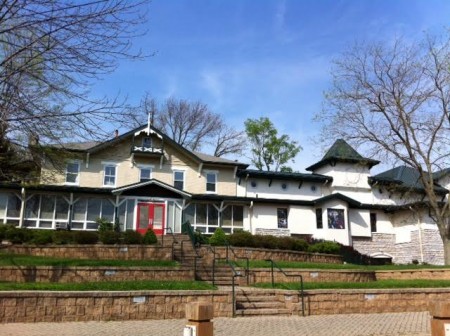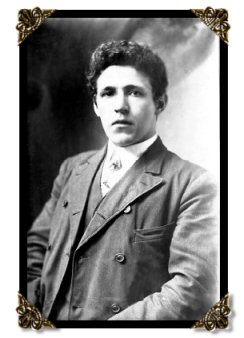Where can you see a mastodon jawbone from 10,000 B.C. and a streetcar built in 1892 in one location?
The Behringer-Crawford Museum in Covington, Kentucky offers 450 million years of Northern Kentucky history and culture viewed through the lens of transportation – rivers, roads, rails and runways. Ongoing creative, innovative and family programs are also available. A regional museum, it has documented historic Civil War battery sites in Kenton and Campbell counties.
The museum is housed in the original 1848 William Devou residence hidden away in Devou Park located in the rolling hills of Covington, Kentucky. A Cincinnati milliner, Devou left a 1910 will that indicated the house would become an art museum or a library.
William Jr., one of Devou’s sons, lived in the West End as a landlord. With matching Work Projects Administration (WPA) funds, he set up a trust fund for upkeep of the original house. His other son Charles remained living in the home and became its first superintendent. After he died and the family moved to California, the city of Covington rented the home from the Rich family from the mid-1920’s to 1943, when a fire occurred.
When Covington resident, builder and world traveler William Behringer died, his family donated his natural history collection to the museum, which opened as the William Behringer Memorial Museum in 1950. Visitors could see a mounted, stuffed black bear, preserved birds, small game, a two-headed calf and American Indian artifacts.
Ellis Crawford was the museum’s first curator and archaeologist, who focused on Northern Kentucky pre-historic cultures. He knew about fossils and helped create Big Bone Lick Park in Boone County in the 1960’s. The mastodon jawbone from this park is on display at the museum.
When Crawford retired in 1970, the city of Covington renamed the organization The Behringer-Crawford Museum to honor him as well as Behringer. The museum closed in the late 1970’s for budgetary reasons. Greg Harper was the first executive director in 1979, when an independent board was formed. The museum reopened in 1980.
Renovations to the museum included a veranda addition in 1984. Fifth Third Bank donated funds for a Schmidlapp Amphitheater in 1994. It is a 300-plus seating area outdoors for programs, events and concerts. In 2007, the Mark and Rosemary Schlachter Family Wing added 15,000 square feet of new exhibit developments and a collection care facility for artifact storage.
A visit to the museum provides an inside, unusual and in-depth view of Northern Kentucky’s development. Its mission is to “serve the regional history of Northern Kentucky as part of the Ohio Valley for the benefit of present and future generations.”
“We are a destination,” said Laurie Risch, executive director since 1993, who said the Off the Beaten Path travel company has featured the museum in its publicity. She described the transportation theme in detail.
The Ohio River is the single most important water source for the region, according to BCM’s website. Over time, flatboats became the mode of transportation until steamboats entered the area. The museum displays miniature riverboats, including a replica of the Delta Queen. Along with the depiction of the queen of Ohio River Steamboats are such artifacts as keys to staterooms, boarding tickets and checks.
Downtown Bridges highlights nine of the area’s bridges. The Roebling Suspension Bridge was the prototype for the Brooklyn Bridge in New York. Visitors travel through time by walking through an indoor bridge, a model Suspension Bridge built by Murphy Catton Exhibit Designers from Walton, Kentucky.
Enjoy the Open Road which deals with suburbanization in the region, particularly after World War II. Communities in Northern Kentucky were built for veterans of the war. Cars became a popular transportation mode, according to Risch. On floor two, the Greater Cincinnati Auto Case displays newspaper ads, articles and artifacts.
Traveling Along the Tracks showcases the rise of rails in the area. Commercial and river traffic decreased as railways proved to be a cheaper means of operating business. The train exhibit has railroad spikes, repair tools and boarding tickets.
On the first floor is the Kentucky streetcar, believed to be the last four-wheel parlor car in original and operating condition in the United States. Built as a standard car by the Brownell Car Company, the Kentucky was rebuilt as a first class car in 1911. It was the last car to operate on the Cincinnati, Newport and Covington Railway Line.
Cincinnati/Northern Kentucky International Airport located in Boone County has become the airline hub for the area. Lunken Airport was originally the airport for the region. Due to river floods and fog issues, ‘Sunken Lunken’ was replaced by CVG airport named after Covington, the largest city in Northern Kentucky.
David Schroeder, executive director, Kenton County Public Library, said, “To me, the Behringer-Crawford Museum is the only institution preserving physical history of Northern Kentucky through its display of artifacts. It gives everyone from children to adults the opportunity to learn about the history that connect us to our past in a visual way.”
A majority of the permanent exhibits focus on the mid-1800’s through 1940. Visitors come alone or bring their families where children in costumes can play with toys and trains. Kids can become a junior tour guide, a junior naturalist and participate in a fossil hunt. BCM asked POD Designs to create a Nature Play area, similar to the one at the Cincinnati Nature Center. It opens in the summer of 2016.
The holiday display from late November through early January features toy trains each year. This interactive exhibit is perfect for small children. The local Northern Kentucky chapter of The National Association of Miniature Enthusiasts and the River Valley Wood Carvers’ Club partnered with BCM for this exhibit.
Special exhibits play an important part in the museum’s existence. Silent Storytellers runs from February 27 to May 15. Featuring rarely displayed artifacts from the museum’s collections and other family archives, the exhibit reveals how heirlooms preserve ancestral memories while reminding visitors of the people and traditions that impact lives today. For example, the exhibit includes the William Devou Sr. family Bible, a Spanish-American War uniform and a Stodart, Worcester, Dunham pianoforte from 1836.
Next is The Forgotten War: Northern Kentuckians in the Korean Conflict opening June 4. Based on interviews, oral histories and military and personal effects, this exhibit honors the contributions of local veterans in the Korean War, according to Risch. These personal war stories shed new light on this era in American history. The exhibit runs through August 28.
A relatively new interactive exhibit gives visitors the opportunity to dig for artifacts. Digging for Answers allows visitors to sift through sand and dig for artifacts like an archaeologist.
In her years at the museum, Risch has worked on establishing what it means to be a museum. There are four floors with 16 permanent exhibits which focus mainly on Northern Kentucky heritage in addition to four rotating exhibits.
Local artist Wolfgang Ritschel (1933 – 2010) created Northern Kentucky stained glass scenes, three of which are housed at BCM. They are Peoples of Northern Kentucky, Paleontology of Northern Kentucky and Transportation of Northern Kentucky.
Ritschel was born in Trautenau, now the Czech Republic. He spent his life in pursuit of scientific research and artistic expression. As a professor for the University of Cincinnati’s Colleges of Medicine and Pharmacy, Ritschel became internationally renowned for his scientific contributions in pharmacokinetics, a discipline that studies the distribution and disposition of drugs in the human body.
Ritschel’s passion for art began at age 14. He continued his interest throughout his academic career by continuing his training at the Art Academy of Cincinnati, among other institutions. Landscapes and cityscapes are the subjects for most of Ritschel’s painting. Influenced by his many trips to South America and the Andes Mountains, Ritschel’s color palette is inspired by the altered perception of colors at high altitudes.
Another Northern Kentucky artist was Harlan Hubbard (1900 – 1988). He donated many works of art to the museum, including Bridge in Newport, Kentucky, (oil on tin; 1951); Kentucky Winter Hillside, (oil on tin; 1940) and Kentucky Landscape/Double Log Home (watercolor; 1943).
After studying art in New York and Cincinnati, Hubbard moved to Ft. Thomas, Kentucky. He was an accomplished artist and author. His artwork is largely pastoral and often inspired by his surroundings. Through oils, watercolors and woodblock printing, Hubbard captures the complex and simple beauty of nature and everyday life.
The museum will raise money with a Two-Headed Calf Awards event on March 10 at 6:00 p.m. in Northern Kentucky University’s Votruba Student Union Ballroom. These awards honor Northern Kentuckians for significant accomplishments in the areas of history, education and community service. They are named for the museum’s preserved two-headed calf, which symbolizes that true excellence rests with those who demonstrate achievement beyond a single contribution.
For 2016, the awards recognize:
– Normand and Lisa Demarais, service to the community: generosity and vision;
– Theodore H. H. Harris, service to history: scholarship and public service;
– Raymond G. Hebert, service to learning: academic excellence and innovation;
-Joe Brennan, special recognition for excellence in all three award categories.
The museum staff and budget are small. Four full-time, soon to be five, employees work with five part-time and two contract employees. Twenty members of the board come from Northern Kentucky and Cincinnati. Seventy-five volunteers are from Northern Kentucky. Although the annual budget is $400,000 – $450,000, the museum has operated in the black for years.
Over 35,000 people visit the museum annually.
“We’ve come a long way,” Risch said. But, she doesn’t let the show stop here. She has applied for grants and created a strategic plan with the board. Future plans include an auditorium and expansion of the building.
Things to Know:
Address:
Behringer-Crawford Museum
1600 Montague Rd.
Covington, KY 41011
Located in Devou Park in Covington.
Hours:
Tuesday – Saturday 10:00 am – 5:00 pm
Sunday: 1:00 pm – 5:00 pm
Closed Mondays and all national holidays.
Hours may be extended for special events.
Admission:
Adults (18 – 59): $9.00
Seniors (60 +): $8.00
Childrens: $5.00 (3 – 17)
Free to museum members
Free parking
Wheelchair accessible parking is available.
Lawrence Duba Library:
The library houses a non-circulating collection focused on Kentucky history, archaeology, paleontology, natural history and river heritage. Available by appointment.
Website
(859) 491-4003


